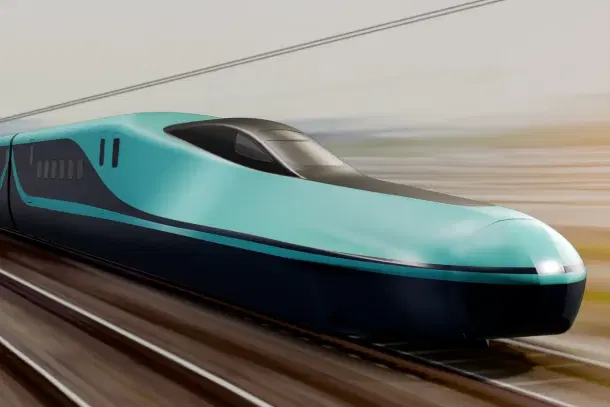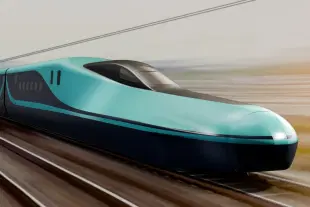News Brief
Mumbai-Ahmedabad Bullet Train: India, Japan Eye New Loan Framework for Next-Gen E10 Shinkansen On High-Speed Rail Corridor
Swarajya Staff
Jul 23, 2025, 11:56 AM | Updated 11:56 AM IST
Save & read from anywhere!
Bookmark stories for easy access on any device or the Swarajya app.


India and Japan are reportedly planning to develop a new loan framework to facilitate the integration of East Japan Railway's (JR East) next-generation E10 Shinkansen trains into the Mumbai-Ahmedabad bullet train project.
This collaboration aims to bolster the ambitious 508-kilometre high-speed rail link between the two cities, a crucial part of India’s transportation infrastructure.
E10 Trains and the Evolving High-Speed Rail Landscape
The E10 series is set to be a groundbreaking addition to the Mumbai-Ahmedabad project.
Originally, the E5 series Shinkansen was selected for this corridor, but with delays and rising costs, India began reconsidering the use of domestically produced trains.
To resolve this deadlock, Japan proposed the introduction of the E10 trains, which is reportedly accepted by India as a viable solution.
As part of the plan, Japan intends to supply India with inspection vehicles from the E5 and E3 Shinkansen series. These inspection trains, fitted with specialized equipment, will reportedly arrive in India in early 2026 and are expected to assist with testing the rail infrastructure under Indian conditions, such as high temperatures and dust.
The data collected from these trains will be crucial for the future production of the E10 trains in India.
New Loan Framework to Address Rising Costs
The Mumbai–Ahmedabad High-Speed Rail (MAHSR) project is primarily funded through a collaboration between the Government of India and the Japan International Cooperation Agency (JICA).
The collaboration between India and Japan began in 2015, with a landmark agreement to introduce Japanese Shinkansen technology into India’s first high-speed rail network.
JR East is slated to begin commercial operations of the E10 series in 2030, with the final train model scheduled for completion in September 2027.
To finance the escalating costs of the project, which were initially projected at Rs 1.05 lakh crore, both governments are working on a new loan framework for the project.
This new arrangement will enable the introduction of E10 trains on Mumbai-Ahmedabad bullet train project, which is set to partially open by 2027.
Prime Minister Modi’s Upcoming Visit to Japan
Prime Minister Narendra Modi's upcoming visit to Japan in August is expected to solidify this collaboration, with a particular focus on the introduction of the E10 Shinkansen technology and the new loan framework.
During his visit, PM Modi is scheduled to tour the Miyagi Prefecture plant, where the E10 prototype is under development.
Discussions will also cover broader economic cooperation, notably Japan’s ambitious $34.2 billion investment plan for India over the next five years.
Project Timeline
The Mumbai-Ahmedabad High-Speed Rail (MAHSR) project, one of India’s most significant infrastructure initiatives, is expected to be ready for partial operations by 2027, initially utilizing domestically produced trains before the introduction of the E10 series.
This project will pass through Gujarat, Maharashtra, and Dadra and Nagar Haveli, with 12 planned stations including key locations like Mumbai, Surat, and Ahmedabad.
New Next-Gen Shinkansen E10 Trains
Key Features of the E10 Series:
Enhanced Safety Measures: Building upon technologies tested in the "ALFA-X" next-generation Shinkansen development platform, the E10 series will incorporate L-shaped vehicle guides to prevent derailments during earthquakes.
Additionally, the adoption of lateral dampers aims to reduce braking distances and absorb shocks, minimizing potential damage and derailment risks.
Passenger-Centric Design: The E10 series plans to offer an upgraded "TRAIN DESK" service, expanding luggage storage areas and equipping all seats with power outlets to enhance passenger comfort.
Efforts to improve accessibility include the introduction of wheelchair spaces that provide unobstructed window views.
Sustainability Initiatives: The train will feature systems compatible with "smart maintenance," allowing for condition-based upkeep.
Innovations such as blower-less induction motors, which eliminate the need for cooling fans, and the use of high-efficiency silicon carbide (SiC) elements in the train's drive inverters are expected to improve energy efficiency.
Exterior Design:
The E10 series will feature a green color scheme inspired by the mountains of the Tōhoku region.
The upper section will be painted in "Tsugaru Green," a light green shade, while the lower section will be in a darker "Evening Elm" green.
Notably, the design of the E10 series marks JR East's first collaboration with an overseas design firm, London-based strategic design company tangerine.




